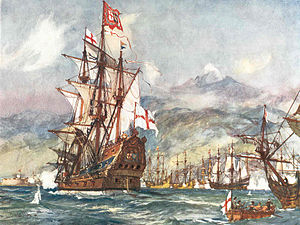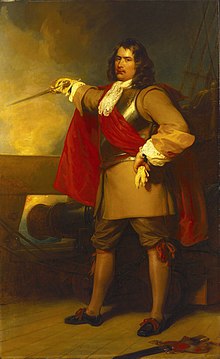Anglo-Spanish War (1655-1660)
| date | 1655-1660 |
|---|---|
| place | Spain, Caribbean, Canary Islands, Spanish Netherlands |
| output | Victory of England |
| consequences | Jamaica, Dunkirk and the Cayman Islands come to England. Treaties of Madrid (1667 and 1670 ) |
| Peace treaty | 1660 after Charles II ascended the throne as King of England |
| Parties to the conflict | |
|---|---|
| Commander | |
|
Caribbean: Bernardino de Meneses Cristóbal de Isasi Spain: Pablo Fdez. de Contreras Marcos del Puerto Diego de Egüés Flanders: Willem Bette Juan José de Austria Luis de Condé |
|
The Anglo-Spanish War was a military conflict between the Commonwealth of England and the Kingdom of Spain from 1655 to 1660 . It was opened by the English for economic and religious reasons and ended in September 1660. England secured Jamaica , Dunkirk and the Cayman Islands in it .
prehistory
The war against Spain was planned by the English government under Lord Protector Oliver Cromwell . England had successfully completed the First Anglo-Dutch Sea War 1652–1654 and was now seeking to profit from the ongoing conflict between its traditional enemies Spain and France, who had been at war since 1635 ( Franco-Spanish War ). It was decided to use the powerful fleet built during the Civil War to attack the Spanish colonial empire in America. The aim of the English, who had so far mainly appeared in the pirate war , was above all to gain bases in the Caribbean controlled by Spain .
Course of war
Sea war in the west
During the war, Admiral Robert Blake blocked the port of Cádiz and in 1656 one of its captains, Richard Stayner , destroyed part of the Spanish silver fleet . Two fully loaded galleons were captured. The capital gain for England was estimated at £ 3,000,000. The Western design was Oliver Cromwell's attempt to get the Spanish colonies in the Caribbean under English rule in the spring of 1655. In May 1655 an invading fleet of Admiral Sir William Penn (father of the founder of Pennsylvania) occupied the island of Jamaica with the troops of General Robert Venables .
In 1657 the governor of Jamaica offered the Caribbean pirates the port of Port Royal as a base in exchange for their support in the fight against the Spanish. On April 20, 1657, Admiral Blake continued to destroy a Spanish navy of sixteen ships in the battle of Santa Cruz on Tenerife . He lost only one ship himself in the process, although he was under heavy fire from the coastal batteries and the tides were unfavorable for a fight. The Spanish treasure fleet was thus exposed to the blockade ships of the British, practically defenseless.
In 1657 and 1658, the Spanish attempted to regain Jamaica from Cuba but lost the battles of Ocho Rios and Rio Nuevo . Despite the capture of Jamaica, the main goal, the conquest of the island of Hispaniola , was not achieved by the English.
Alliance with France
During the first years of his protectorate, Cromwell negotiated with Cardinal Mazarin about an Anglo-French alliance against Spain. He believed that separating the Spanish Netherlands from Spain, even if this initially favored France, was in the interests of England. In any case, it is better to participate than to leave it to others. France showed its appreciation by undertaking not to grant asylum to the members of the House of Stuart .
The treaty signed in Paris in March 1657 sealed that the English would support the French in their war against Spain in Flanders . France would raise an army of 20,000 soldiers and England would contribute 6,000 redcoats to the New Model Army . At the same time, the English fleet was to launch a campaign against the Flemish coastal forts of Gravelines , Dunkirk and Mardyck . After the conquest, the fort in Gravelines was to be handed over to France. Dunkirk and Mardyck were to get the English.
Land war in Flanders
The united Franco-English army for the invasion of Flanders was commanded by the French Marshal Turenne . The Spanish army was led by Don Juan José de Austria , an illegitimate son of the Spanish King Philip IV. The Spanish army of 15,000 men was supported by 3,000 British loyal to the king who formed the basis of an invasion army that was still to be formed, with Charles II. England wanted to attack. One of the commanders was James, Duke of York , a brother of Charles and later King James II of England.
The English fleet blocked the Flemish ports, but to Cromwell's annoyance, the land campaign was delayed until the end of the year and was constantly being postponed. Marshal Turénne spent the summer of 1657 fighting the Spanish in Luxembourg and made no move to attack Flanders until September. Mardyck was captured on September 9th and occupied by English troops. Dunkirk was besieged in May 1658.
A Spanish relief army intended to break the siege was defeated in the Battle of the Dunes on June 14th . The English contingent of troops in Turénne's army fought sacrificially and impressed Turénne with an attack on a heavily fortified 50 m high sand hill. When Dunkirk finally surrendered on June 14th, Cardinal Mazarin kept the deal and handed the city over to the English, despite protests from French King Louis XIV . In return, England fulfilled its promise to uphold the rights of the Catholic people of Mardyck and Dunkirk.
Part of the English troops remained with the Turénne army and helped capture Gravelines and two other Flemish cities.
Peace treaty and consequences
The war between France and Spain ended with the signing of the Peace of the Pyrenees on October 28, 1659. After Cromwell died and Charles II was installed as the new king in England, the Anglo-Spanish War was officially ended in September 1660. Charles sold Dunkirk to France in November 1662.
Jamaica and the Cayman Islands remained English colonies. In 1670, with the Treaty of Madrid , the Spanish recognized the possession of the islands by England.
Web links
- David Plant: The Anglo-Spanish War 1655–60 (as of February 2, 2008)
literature
- Toby Barnard: The English Republic 1649-1660 , Addison-Wesley Longman Limited, London / New York 1997. ISBN 0-582-08003-7
- Heinrich Bauer: Oliver Cromwell - A struggle for freedom and dictatorship , published by R.Oldenbourg, Munich / Berlin 1940.
- Hepworth Dixon: Robert Blake - Admiral to General at Sea , Chapman and Hall, London 1852.
- GMD Howat: Stuart and Cromwellian Foreign Policy - Modern British Foreign Policy , London 1974.
- Heinz Kathe: Oliver Cromwell , Akademie-Verlag, Berlin (East) 1984.
- Charles P. Korr: Cromwell and the new Model Foreign Policy - England's Policy toward France, 1649–1658 , Berkley / Los Angeles / London 1975.
- Helmut Pemsel : Seeherrschaft , Vol. 2, Vienna / Garz 2005. (= Helmut Pemsel: Weltgeschichte der Seefahrt , Vol. 5)


